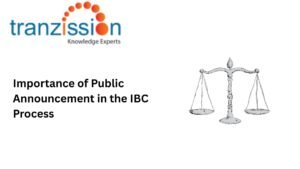
Role of IBC in Corporate Governance
Table of Contents
The platform of a robust business environment is having effective corporate governance. Since its establishment, Role of IBC in Corporate Governance Insolvency and Bankruptcy Code, 2016 (IBC) has had a significant impact on reviving, restructuring, or rehabilitating companies in financial distress. In addition to this, it has emerged as a vital instrument in advanced corporate governance practices in India. Therefore, it is important to understand the impact of the IBC on corporate governance.
Understanding Corporate Governance Under IBC
Corporate governance under the IBC focuses on reviving distressed companies by maximising the value of their assets. To understand its role in the resolution process it is important to understand what corporate governance is and its challenges:
Defining Corporate Governance:
Corporate governance is the system of rules, practices, and processes by which a company is directed and controlled. It primarily focuses on managing the business to maximise its long-term value, safeguard the interest of all stakeholders, and support economic growth and financial stability.
Governance Challenges in Insolvency:
When a company has been declared ‘insolvent’, there are many issues that arise because of it. For instance, there may be a lack of transparency, accountability, and effective decision-making due to conflicts among stakeholders, which lead to mismanagement, fraudulent activities, and unfair treatment of creditors during the resolution process. The IBC has introduced mechanisms to enhance governance, such as appointing resolution professionals and ensuring stakeholder involvement ensure stakeholder involvement.
IBC’s Contribution to Strengthening Corporate Governance
The IBC contributes to strengthening corporate governance by providing a transparent and time-bound process for resolving the financial issues of distressed companies. It has also improved the management of insolvent companies, ensures creditor protection, and prevents fraudulent, preferential, or undervalued transactions.
Professional Management of Insolvent Companies:
Insolvency professionals have the role of managing the insolvency and liquidation proceedings of the IBC and ensuring the company continues its business operations as a going concern. The resolution professionals assume control over the company during the corporate insolvency resolution process (CIRP) to ensure that decisions align with the interests of creditors and stakeholders.
Creditor-Centric Approach:
By giving the creditors an important role in the CIRP, the IBC prioritises their interests and discourages practices that adversely affect the creditors. For instance, financial creditors constitute the Committee of Creditors (CoC) and have a role in deciding the resolution plan. This enhances accountability and reduces promoter interference in distressed companies.
Transparency in Decision-Making:
The insolvency process ensures transparency by ensuring the required details are public, where all the stakeholders have access to information about the company’s financial health and stage of the process. All critical decisions during insolvency proceedings are subject to creditor and tribunal approval, promoting transparency and fairness.
Independent Oversight:
The National Company Law Tribunal is the Adjudicating Authority as per section 5(1) of the IBC, and has the duty to oversee the insolvency cases. This ensures fairness, transparency, and adherence to the IBC and relevant rules and regulations.
Avoidance of Fraudulent Practices:
Sections 43 to 51 of the IBC address fraudulent, preferential transactions, extortionate credit transactions, or undervalued transactions. The resolution professional can challenge and set aside such transactions made by the company nearing insolvency within a ‘look back period’, which is generally 2 years. This allows the proceeds from the sale of the company’s assets are distributed fairly among the creditors.
Read more : Four Pillars of the Insolvency and Bankruptcy Code, 2016
Key Provisions of IBC Promoting Governance
- Section 17: Under this section, the interim resolution professional (IRP) manages the affairs of the corporate debtor. This means that the powers of the board of directors are suspended during CIRP and the IRP manages the company until further stages in the insolvency process. This includes the power to access documents, where the managers of the company must report to IRP with such documents. This is beneficial to corporate governance as it eliminates conflicts of interest among the stakeholders.
- Section 29A: This section disqualifies any individual to be a resolution applicant who has defaulted, been convicted of certain crimes, has been disqualified under the Companies Act, 2013, or has previously managed a company that went through insolvency proceedings. Such promoters or individuals are hence prevented from taking advantage of the insolvency process to regain control of the company and enforce accountability.
- Resolution Plans: The purpose of drafting a resolution plan is to enable the struggling company to recover financially through payment plans and the possibility of restructuring while prioritising the interests of the creditors. The IBC mandates that resolution plans must be fair and equitable, protecting all stakeholders.
Benefits of IBC-Driven Governance
IBC-driven governance has several advantages, an efficient resolution process, improving rates of recovery for creditors, transparency during the CIRP, improving foreign investments, etc.
Enhanced Stakeholder Confidence:
The IBC’s creditor-centric approach allows creditors to participate actively in the resolution process and increases their chances of recovering their debts from the company. This ensures greater transparency and creditor involvement which rebuilds the trust in distressed companies.
Effective Asset Utilization:
IBC-driven governance promotes effective asset utilisation by providing a transparent and time-bound process. The insolvency process aims at maximising the value of the company’s assets by encouraging creditors to participate in CIRP, which leads to better allocation of proceeds. Hence, the insolvency process ensures that company assets are preserved and utilized efficiently during CIRP.
Prevention of Mismanagement:
Through section 29A of the IBC promoter influence is minimised, which reduces opportunities for financial irregularities. Having a transparent insolvency process empowers creditors to initiate CIRP, and enables the investigation of any fraudulent transactions. Thereby, the IBC encourages any party involved in the resolution process to maintain corporate behaviour.
Boost to Foreign Investments:
IBC provisions showcase India’s commitment to ethical business practices. This robust governance framework attracts foreign investors through mitigating risk management and instilling confidence in international investors.
Challenges in Implementing Governance Through IBC
Implementing IBC has several challenges, such as judicial delays, promoters may resist and find loopholes in insolvency laws, creditors are not aware of their rights, and difficulty in balancing the stakeholders due to the complexity of IBC provisions.
- Delays in Resolution: The prescribed time under section 12 of the IBC for completing the insolvency process is 330 days. However, this time limit is often crossed due to the NCLT being overburdened, frequent litigation and appeals, and navigating the complexity of insolvency cases. This may hinder swift governance improvements.
- Resistance from Promoters: Promoters may attempt to oppose or use the insolvency process to relinquish control of the company, preventing any legal consequences for past management decisions.
- Limited Awareness: Many stakeholders lack awareness of their rights and obligations under IBC which prevents them from taking measures to protect their interests during the insolvency process. This may eventually lead to poor governance practices, such as inefficient resolution processes, mismanagement, and reducing the rate of recovery.
- Balancing Stakeholder Interests: The process of managing the resolution of an insolvent company involves balancing all stakeholder’s interests to ensure that no preference is given to any one creditor, which is difficult for an insolvency professional. This is because stakeholders have conflicting interests, and each stakeholder may have a different influence.
Recommendations for Strengthening Corporate Governance via IBC
To strengthen corporate governance through the IBC, companies can take the necessary measures to revive, restructure, or rehabilitate themselves, ensure that all creditors are repaid, and comply with the necessary laws, rules, or regulations.
- Capacity Building for RPs: The Insolvency and Bankruptcy Board of India (IBBI) is recommended to adopt measures to develop the skills and knowledge of insolvency professionals. This can ensure efficient and effective management of insolvency cases, improving the process of corporate restructuring under the IBC.
- Faster Tribunal Processes: Although the IBC, aims at streamlining the resolution process, there are still judicial delays due to the NCLT being overburdened. Increasing the number of NCLT and Appellate Tribunals and introducing sector-specific tribunals may reduce procedural delays at NCLT and appellate levels.
- Leveraging Technology: Artificial intelligence and blockchain technology can be used by insolvency professionals for transparent voting, and documentation, and to make more informed decisions during CIRP.
- Stakeholder Education: Stakeholder education can improve the insolvency process by ensuring all stakeholders have a clear understanding of their rights, responsibilities, and insolvency or liquidation proceedings. For instance, awareness programs for creditors and employees can help them understand their roles in the governance process.
Case Studies Illustrating Governance Reforms Under IBC
- Jaypee Infratech Ltd. Case: This case has impacted the governance reforms by highlighting the need for robust creditor protection, an efficient resolution process, and providing clear legal interpretations. The NCLT order emphasizes the complex corporate structures and the treatment of homebuyers in distressed complex real estate projects. This case laid down the foundation for the facilitation of IBC on the resolution process while protecting homebuyers’ interests, emphasizing fair governance.
- Bhushan Steel Case: The Bhushan Steel Case is a landmark case to show how IBC can be used to resolve the distress of large companies. In this case, creditors were allowed to initiate a resolution process to find a new owner and restructure the debt, thus demonstrating the potential for governance reforms in India. The outcome of this case was a successful takeover by Tata Steel showcasing how IBC-enabled governance can turn around distressed companies.
Read more : Forensic Audit in the Insolvency and Bankruptcy Code, 2016
The Future of Corporate Governance Under IBC
IBC is evolving as a cornerstone for governance reforms, fostering ethical business practices and ensuring fair treatment for all stakeholders. The advancement in technology can also be utilised by insolvency professionals to simplify the process of collecting and submitting documents and balancing the interests of all stakeholders. For instance, the integration of artificial intelligence, data analytics, and blockchain can further enhance transparency and accountability in insolvency processes.
Conclusion : Role of IBC in Corporate Governance
IBC has played a transformative role in enhancing corporate governance in India. The insolvency framework prioritises creditor interests by providing them with active participation in the insolvency process. Corporate governance is positively impacted by the involvement of qualified insolvency professionals who provide their expertise and objectivity in evaluating company viability and formulating resolution plans. The mandated disclosure requirements under the IBC promote transparency, minimising asset depreciation, and maximising recovery value for creditors, thereby improving corporate governance.





